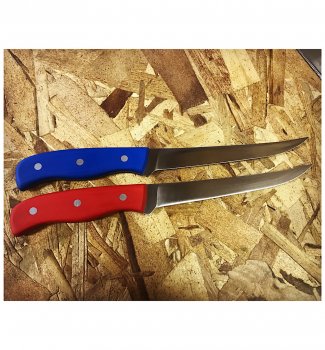i’m glad I’m not the only one that has trouble sharpening it. I always heard it was dirt simple to sharpen but I sure did have a tough time of it. Also seemed much harder to hand sand then carbon steel. Understandable with stainless but I always heard that AEB-L Behaved similar to carbon steel.
OOF. I feel this one. AEBL can be a real pain to sharpen. As in a broaden your vocabulary experience. I have come to the point where it actually is very easy to sharpen, but there are some critical watch-outs and learning them kicked my butt. Hard.
I don’t mean to come across as the AEBL expert. I’m just sharing my experience that came to me over the course of the last 150 knives or so since I started using it almost exclusively.
1. You MUST take your edge to .005 - .010 when grinding bevels. If you don’t you’ll kill yourself trying to get your initial edge on the blade.
2. You MUST get a visible burr on the edge before going up in grits. It’s very easy to assume that the burr went away without you noticing. WRONG!! This steel produces the toughest burr I’ve ever seen. If you don’t get it off, the edge will go from laser sharp to dead dull instantly. That’s not edge failure, that is the wire edge laying over. If you don’t get that wire edge off (the burr) this steel will have you pulling your hair out.
3. The burr looks like ragged foil when belt sharpening. You aren’t done on a given belt until you see that foil burr running away and off the tip as you make a pass.
4. Get an actual edge before you try to convex. You need to drop back in grits if you aren’t getting an edge or a burr. This steel is tough as snot. If there is any flat spot whatsoever along the edge, you aren’t going to get a sharp edge on a slack belt. Forget it. Steepen your angle and grind an actual “ ^ “ edge that has no flat spots. Flat spots look shiny under strong light. If there is any shine on your cutting edge you have a flat spot and you need to grind, not sharpen.
5. Finish on a strop. That pesky burr is no joke. It won’t flake off on its own. You really want to strop. If there’s no burr, AEBL should slice phone book paper like smoke. If it drags in spots you have a burr there.
So, AEBL is almost just like carbon steel except for that persistent burr / wire edge being a pain. Once you know to look for it and to remove it visibly the world becomes a much happier place.
AEBL isn’t unique in any of this. All stainless acts like this. The AEBL burr is just more persistent than usual.

